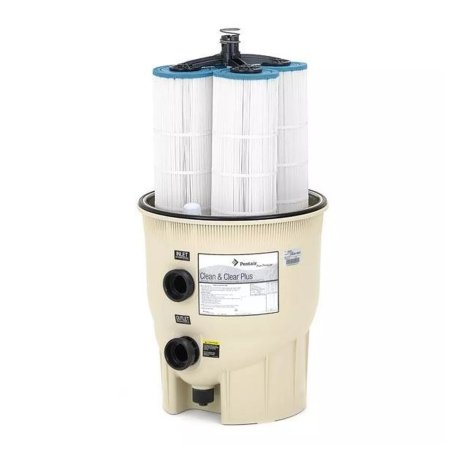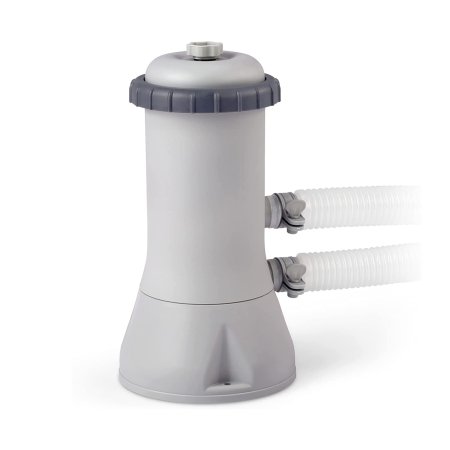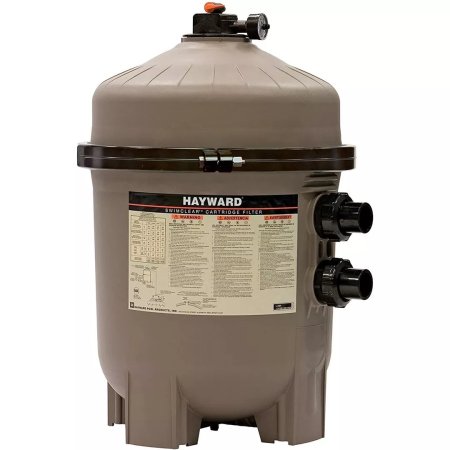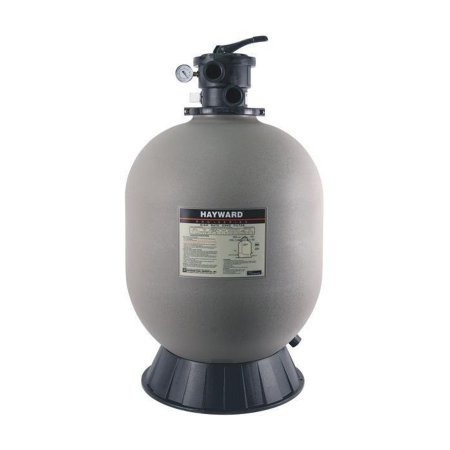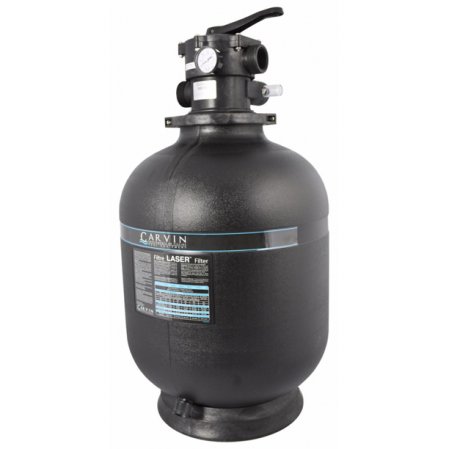We may earn revenue from the products available on this page and participate in affiliate programs.
Reading up on Domino’s shopping guides is like having your own personal product concierge. We do the tedious part—deep-dive research, hands-on testing, and tapping experts for advice—so all you have to do is hit “add to cart.” That’s why we call them Simply the Best.
You may have the dream fiberglass pool surrounded by lush landscaping, stunning loungers, and a Cali-cool cabana, but without the best pool filter, your backyard risks looking a lot less inviting. Ever seen a fish tank with murky, unfiltered water? Pool filters—the handy pieces that limit algae and bacteria—keep your pool from ever reaching that shade of cloudy green.
There are plenty of filters on the market to choose from, but picking out the right one for you is key. To start, you’ll need to do a little math to determine how many gallons yours will need to process per day. To help guide you for what’s next, we had pool contractors weigh in with their tips and recommendations. After narrowing down the best pool filters based on their suggestions, here are the standouts to consider.
Our Favorites
- Best overall: Pentair Clean & Clear Plus Cartridge Pool Filter
- Best value: Intex Krystal Clear Cartridge Filter Pump
- Best D.E.: Hayward ProGrid for In-Ground DE Pool Filter
- Best sand: Hayward Pro Series Pool Sand Filter
- Best for aboveground: Carvin Laser Above Ground Swimming Pool Sand Filter
Best Overall: Pentair Clean & Clear Plus Cartridge Pool Filter
Best Overall
Filters up to: 150 gallons per minute | Valve control: Yes | Type: Cartridge | Flow rate: 150 GPM
What we like:
- Easy-to-change filters
- Zinc kills bacteria
- Durable tank
Worth noting:
- Expensive
- May need professional installation
Why we chose it: Easy-to-replace filters make this cartridge model a no-fuss option.
For an easy route to a sparkling clear pool, this style of cartridge is very low-maintenance thanks to its easy-to-replace filters, says Steven Combee, construction manager at Premier Pools. Penair’s version features four zinc plates where water runs through to ionize and kill any bacteria. It can filter an area of 420 square feet and up to 150 gallons per minute, making it a match for most average-size pools, and there is internal and manual air relief to maintain good water pressure.
The filters themselves can capture supersmall particles, including algae and bacteria. While you’ll have to rinse them off every four months, you’ll only have to replace each individual filter every year or so, depending on the size of your pool. Keep in mind that this type does tend to run on the pricier side.
Best Value: Intex Krystal Clear Cartridge Filter Pump
Best Value
Filters up to: 6,000 gallons | Valve control: Yes | Type: Cartridge | Flow rate: 1,000 GPH
What we like:
- Easy to install
- Affordable
- Replaceable filters
Worth noting:
- Only good for small pools
Why we chose it: Small pools need constant filtration, too, and this inexpensive model gets the job done.
If you have a smaller aboveground pool or plunge pool in your yard, this tiny but powerful cartridge filter will do the trick. To note—it’s only good for pools with 6,000 gallons of water or less, as it filters 1,000 gallons per hour. Psst: This pump also uses the same simple cartridge filter style that Combee recommends, so installing it is a breeze. As long as you hook it up to a pool size no larger than its maximum (6,000 gallons), you should have immaculate water in no time.
Best D.E.: Hayward ProGrid for In-Ground DE Pool Filter
Best D.E
Filters up to: 6,000 gallons | Valve control: Yes | Type: Diatomaceous Earth | Flow rate: 120 GPM
What we like:
- Captures particles as small as dust and spiderwebs
- Works with large pools
- Doesn’t need a lot of attention
Worth noting:
- Cleaning can be messy
- Pricey
Why we chose it: If you want to get into the nitty-gritty, this filter captures particles as small as dust and spiderwebs.
For filtration that can clear even the small stuff (tinier than gnats and dirt), Diatomaceous Earth (D.E.) pool filters are your best bet. A filtration grid coated with this earthy material can capture some of the smallest particles, and the Hayward ProGrid does just that. Water passes through the D.E., which traps tiny bits and then releases the water back into your pool crystal clear; it also nabs larger leaves and bits in the process. This pick offers a flow rate of 120 GPM (the lower the flow rate, the better filtering you can expect), making it ideal for medium to large pools.
Cleaning this filter can be a bit of a headache compared to some of the others on this list since you have to replace all of the D.E. But it requires less frequent attention and offers a stronger return jet compared to sand filters.
Best Sand: Hayward Pro Series Pool Sand Filter
Best Sand
Filters up to: 21,000 gallons | Valve control: Yes | Type: Sand | Flow rate: 120 GPM
What we like:
- A natural way of filtration
- Made of corrosion-proof, reinforced thermoplastic
- More affordable than a cartridge model
Worth noting:
- Requires 500 pounds of sand
Why we chose it: This heavy-duty filter uses osmosis to filter out water—and as a bonus, doesn’t need to be tended to for at least five years.
Sand filters are an affordable, and therefore popular, option for many pools. The system uses osmosis to draw water evenly up the deep bed of sand in the filter tank, allowing for natural filtration and a high flow rate. The pump is also equipped with a Vari-Flo Valve that can easily be adjusted for other functions like rinsing, draining, and winterizing, making those pesky pool cleaning tasks that much easier. At 30 inches, the Hayward can easily filter the water of an average-size in-ground pool.
Like all sand pool filters, this will require you to occasionally rinse the grime out of the sand, and the sand will need to be replaced every five years or so. “The only issue with [sand filters] is about once a month, you’re going to backwash out a whole lot of sand,” Combee says. “But on the upside, these models are typically less expensive.”
Best Aboveground: Carvin Laser Above Ground Swimming Pool Sand Filter
Best Above Ground
Filters up to: 16,000 gallons | Valve control: Yes | Type: Sand | Flow rate: 120 GPM
What we like:
- UV- and corrosion-resistant tank
- Low-maintenance
- Good for aboveground pools
Worth noting:
- Holds 250 pounds of sand
Why we chose it: Made with smaller, aboveground pools in mind, this sand filter is great for ensuring the water keeps flowing.
This sand filter from Carvin was made for aboveground pools, using the same osmosis filtration process as the Hayward Pro. Thin laser sand is meant to evenly direct water across the entire surface of the filter, resulting in higher flows, better filtering, and more efficient backwashing. Its smaller 22.5-inch size still allows it to filter up to 16,000 gallons, which should work for most aboveground pools. Though you need to fill this model with 250 pounds of sand, only minor backwashing maintenance is required–you won’t have to worry about replacing it for five years either.
How We Chose These Products
Pool filters should help take the stress out of cleaning (just like the best pool vacuums) and not inject more chaos to your poolside life. That’s why we evaluated automatic cleaners not only on how easy they are to use, but based on the types of pools they work best with, from tiled and fiberglass to in-ground and aboveground. To help narrow down our search, we tapped pool contractors to share what to look out for while on the hunt for the best pool filters and which models top their list. From there, we found models that were superior in flow rate and required the least maintenance (most filters should keep chugging for years).
Our Shopping Checklist
Types of Filters
Typically, there are three main types of pool filters you’ll probably go with to keep your pool water clean: cartridge, sand, and D.E. Each has its own unique benefits, and depending on your budget and the amount of physical maintenance you’re willing to put in, there’s a filter among these recommendations to match your needs.
Cartridge: This is Combee’s preferred method of pool filtration because the maintenance is so simple. Each cylindrical filter has a pleated filter material, which can capture debris as small as dirt. To work to its best ability, this filter type should be occasionally cleaned with a hose and only needs to be replaced about once per year. The up-front cost may be higher than other filters, but the later replacement filters are relatively inexpensive.
Sand: Using osmosis to pull water up and through the sand, it’s tough for impurities to get by these filters. The sand can filter particles as small as pollen; is relatively easy to maintain; and is a very cost-effective option. Don’t forget that sand filters need to be backwashed, which is essentially running the water in reverse. And you will need to change the sand out every three to five years, which, yes, is a pretty big effort to remove.
D.E.: These are the most effective filters for detailed filtration on this list: They can trap debris as small as dust and spiderwebs. This filter has grids that are coated with D.E. powder and will need to be backwashed, similar to sand filters. By backwashing—which essentially just changes the direction of the water to flush away caked-on D.E. powder that builds up—your filter is cleared out so it can run like a champ. After backwashing is complete, you’ll then replenish D.E. powder back to the filter to recoat it.
Flow Rate and Capacity
To know how efficient your pool filter is going to be, you’ll have to check the flow rate, which is typically measured in gallons per minute (GPH). A pool filter should filter the entire contents of a pool in about eight hours. For example, a pool filter with a flow rate of 120 GPM can service pools up to 57,600 gallons. A filter must also have a flow rate that at least matches the GPH of the pump in order to work efficiently.
Installation and Maintenance
To install your pool filter, you’ll start by hooking it up to your pool pump—aka the power source to get water flowing into the filter to clean your pool. If you’re unfamiliar with the process, it might be best to hire professional help for the first installation and watch from the sidelines.
Most pool filters have features that make performing routine maintenance easy. Some models have quick-release knobs to open the filter, and remove and replace it (including simple cartridge filters). Other sand and D.E. models have multi-port designs with switches that let you winterize, rinse, and back-flush the filter with the turn of a knob.
Ask Domino
Q: What type of filter is best for an in-ground pool?
This all comes down to personal preference. While D.E. filters can diligently remove the smallest of particles, both sand and cartridge filters still do a good job at removing most average particle sizes that can cause a buildup of bacteria and algae.
“The more expensive and sometimes the bigger the filtration system, the less work you’re going to put in yourself, but you’ll be faced with more up-front costs,” Combee says.
Q: Which pool filter is easiest to clean?
A cartridge pool filter is arguably the easiest to clean. You simply need to pull out the filter and rinse it off, and changing it out altogether is a quick swap. Sand and D.E. filters, on the other hand, require you to backwash and replace the material over time, which isn’t exactly a breeze.
Q: Is it better to run a pool pump during the night or day?
You should be running your pump continuously unless you need to turn it off momentarily to clean your filter. “You never want to shut down your pump for an extended period of time,” Combee says. “If your water is not constantly running through with ionizer or chemicals mixed, your pump is going to stagnate on you, causing bacteria and algae to start growing.”
Q: Is a bigger pool filter better?
This relates back to your pool size. You’ll only need a filter that can effectively filter out the maximum gallons of water in your pool within a 24-hour period, Combee says. Anything more is unnecessary.
Q: How much does it cost to replace a pool filter?
Depending on your pool filter type, the replacement cost varies. A cartridge may run you about $30 per piece, whereas you’ll have to replace your sand filter with multiple bags of sand over time.
Q: How often should pool filter cartridges be replaced?
Pool filter cartridges should be replaced once a year if you care for them properly. You’ll need to clean the cartridges every month (in peak pool season) with a hose to remove any buildup so it can run efficiently.
The Last Word
The size of your pool and the amount of time you want to spend tending to your pool filter (maintenance!) will determine the perfect match for your backyard oasis. For most pool owners, a cartridge filter like the Pentair Clean & Clear Plus Cartridge Pool Filter will keep your pool glistening without too much elbow grease to clean it or to change out the filter when it’s time. While more work, those who prefer the affordable price tag of a sand filter can confidently commit to the Hayward pick for clean pool hangs to come.

